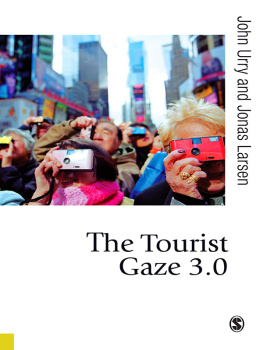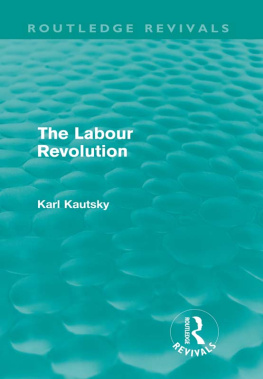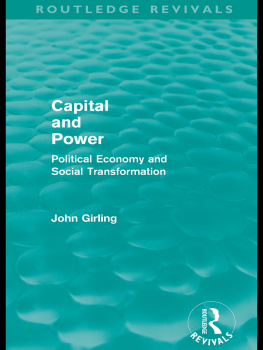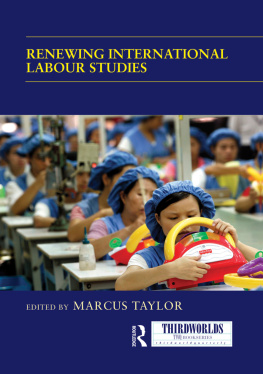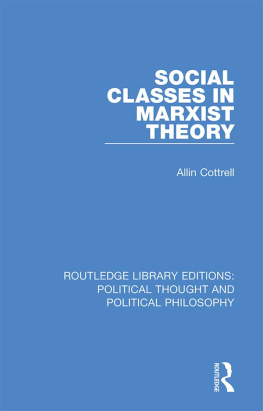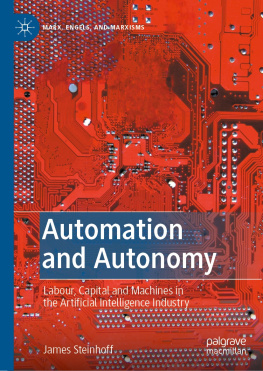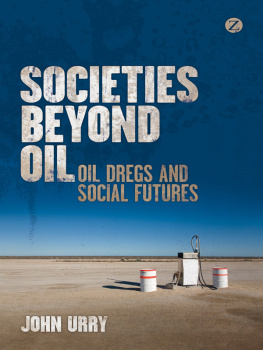ROUTLEDGE LIBRARY EDITIONS: SOCIAL THEORY
Volume 7
CAPITAL, LABOUR AND THE MIDDLE CLASSES
CAPITAL, LABOUR AND THE MIDDLE CLASSES
NICHOLAS ABERCROMBIE AND JOHN URRY
First published in 1983
This edition first published in 2015
by Routledge
2 Park Square, Milton Park, Abingdon, Oxon, OX14 4RN
and by Routledge
711 Third Avenue, New York, NY 10017
Routledge is an imprint of the Taylor & Francis Group, an informa business
1983 Nicholas Abercrombie and John Urry
All rights reserved. No part of this book may be reprinted or reproduced or utilised in any form or by any electronic, mechanical, or other means, now known or hereafter invented, including photocopying and recording, or in any information storage or retrieval system, without permission in writing from the publishers.
Trademark notice: Product or corporate names may be trademarks or registered trademarks, and are used only for identification and explanation without intent to infringe.
British Library Cataloguing in Publication Data
A catalogue record for this book is available from the British Library
ISBN: 978-0-415-72731-0 (Set)
eISBN: 978-1-315-76997-4 (Set)
ISBN: 978-1-138-78223-5 (Volume 7)
eISBN: 978-1-315-76374-3 (Volume 7)
Publishers Note
The publisher has gone to great lengths to ensure the quality of this reprint but points out that some imperfections in the original copies may be apparent.
Disclaimer
The publisher has made every effort to trace copyright holders and would welcome correspondence from those they have been unable to trace.
Capital, Labour and the Middle Classes
NICHOLAS ABERCROMBIE JOHN URRY
Nicholas Abercrombie and John Urry, 1983
This book is copyright under the Berne Convention. No reproduction without permission. All rights reserved.
George Allen & Unwin (Publishers) Ltd,
40 Museum Street, London WC1A 1LU, UK
George Allen & Unwin (Publishers) Ltd,
Park Lane, Hemel Hempstead, Herts HP2 4TE, UK
Allen & Unwin, Inc.,
9 Winchester Terrace, Winchester, Mass. 01890, USA
George Allen & Unwin Australia Pty Ltd,
8 Napier Street, North Sydney, NSW 2060, Australia
First published in 1983
British Library Cataloguing in Publication Data
Abercrombie, Nicholas
Capital, labour and the middle classes. (Controversies in sociology series; 15)
1. Middle classes
I. Title II. Urry, John III. Series
305.55 HT650
ISBN 0-04-301145-4
ISBN 0-04-301146-2 Pbk
Library of Congress Cataloging in Publication Data
Abercrombie, Nicholas
Capital, labour and the middle classes. (Controversies in sociology; 15)
Bibliography: p.
Includes index.
1. Middle classes. 2. Proletariat 3. Social classes.
I. Urry, John. II. Title III. Series.
HT684.A23 1983 305.55 83-3830
ISBN 0-04-301145-4
ISBN 0-04-301146-2 Pbk
Set in 10 on 11 point Times by Red Lion Setters, London, WC1 and printed in Great Britain by Billing and Sons Ltd, London and Worcester
Contents
We are very grateful to Stephen Hill, Roger King, Scott Lash, John Trevitt and Alan Warde for their comments on earlier drafts of this book, and to the Sociology Department at Lancaster University for more general encouragement and inspiration. We are also indebted to Maeve Conolly, Wendy Francis and Heather Salt for struggling and re-struggling with the manuscript and eventually turning it into typescript.
We are also grateful to the following for permission to reprint tabular material: Macmillan Publishers Ltd., for , reprinted from J. Gershuny, After Industrial Society.
In this book we shall consider how to analyse one of the most intractable issues in contemporary sociology: what is the class position of that class or classes which is or are in some sense intermediate between labour and capital? We shall survey most of the major recent contributions to such an analysis in the first part of the book; and in the second we shall discuss certain issues raised by this literature in further detail. We do not presume to solve all of these issues here but we do think that we make certain advances in three areas: first, in analysing the differentiation between what we will term the service class and deskilled white-collar workers; secondly, in considering the crucial significance of knowledge, science and education for the constitution of such classes; and thirdly, in investigating some of the important social effects of the development of such classes in modern capitalism. Overall, we believe that classes are to be viewed as entities possessing causal powers and that sociological investigation has to examine the interdependence between these different social forces which possess such powers. We think that much class analysis, which involves the classification of individuals and groups, is relatively less important than analysing the forms of interdependence and struggle, both between classes and between other distinctive social forces considering, in other words, the respective causal powers of the entities under investigation.
We shall also argue that there is something distinctive about the middle classes within contemporary capitalism and that it is therefore incorrect to treat the contemporary middle classes as direct descendants of the eighteenth- or nineteenth-century variants. Thus, when the Rev. Thomas Gisborne first employed the term in 1785 he used it to refer to the propertied and largely entrepreneurial class located between landowners on the one hand, and urban-industrial workers and agricultural labourers on the other, in a society undergoing transition (Bradley, 1975). Modern day uses of the middle class vary considerably (see we shall in fact suggest that neither of the important middle classes is strictly speaking in the middle, and only one is to be viewed as a class.
THE CHANGING COMPOSITION OF WHITE-COLLAR OCCUPATIONS
The phenomenon that has provoked sociological interest in the middle classes has been the growth of white-collar occupations (see Table 1.1). The most noticeable shift in the period 191171 was the steep decline in classes 57 (manual workers) and the growth of foremen and the three white-collar categories clerks, employers and managers, and professionals. Over the years 191171, classes 57 lost over 21 per cent of the total employed population, made up of 6.5 per cent to professionals, over 2 per cent to managers and employers, 9 per cent to clerks, and over 2.5 per cent to foremen. The white-collar categories themselves did not all gain equally. The higher professional group more than tripled in size, managers rather more than doubled, while the size of the employer group declined. The rate of growth of white-collar occupations also varied over time. The growth in the clerical grade, for example, was at its highest in the years 191121, while the higher professional category increased most quickly between 1951 and 1971 (see Routh, 1980, p. 8).
For both men and women there was a shift out of manual work into white-collar occupations. However, the movement out of manual work was greater for women (30 per cent) than for men (16 per cent). Significantly, for women, clerical work was disproportionately the recipient of the outflow from manual work; indeed, the proportion of men employed as clerks hardly increased between 1911 and 1971. As far as the other categories of non-manual work are concerned, the increase in male managers, and higher and lower professionals, was considerably greater than for their female equivalents.





